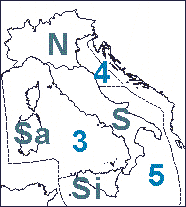Distribution of the Italian fauna
The
geographic information included in the Checklist is: a) distribution of
terrestrial and freshwater species in 4 geographical regions of the Italian
territory (North, South, Sicily, Sardinia); distribution of marine species in 3
areas (western basins, upper and middle Adriatic sea, remaining basins). The
sectors are illustrated in the following map:
|

|
N |
Northern Italy, including:
Friuli Venezia Giulia, Veneto, Trentino-Alto Adige, Lombardia, Val
d'Aosta, Piemonte, Liguria, Emilia-Romagna |
|
S |
Peninsular Italy, including
Toscana, Marche, Umbria, Lazio, Abruzzi, Molise, Campania, Puglia,
Basilicata, Calabria |
|
Si |
Sicily and smaller islands |
|
Sa |
Sardinian and smaller islands |
|
|
|
3 |
western Thyrrenian sea |
|
4 |
northern and central
Adriatic sea |
|
5 |
southern Adriatic, Jonic
sea and other areas |
A preliminary
analysis of the distribution of Italian fauna was discussed by
Stoch (2000) for the invertebrates.
The distribution of Italian species in the geographical regions used in the
Checklist is reported in the following table:
|
|
NtV |
NtI |
Area (km2) |
|
N |
629 |
33414 |
97741 |
|
S |
545 |
24297 |
153710 |
|
Si |
399 |
12988 |
25708 |
|
Sa |
365 |
9841 |
24090 |
|
3 |
455 |
6529 |
- |
|
4 |
317 |
3958 |
- |
|
5 |
394 |
3717 |
- |
Species numbers of total
species of vertebrates (NtV) and invertebrates (NtI), excluding ‘protozoans’,
compared with area of: northern Italy (N); central and
southern Italy (S); Sicily (Si); Sardinia (Sa); western Thyrrenian sea (3);
northern and central Adriatic sea (4); southern Adriatic, Jonic sea and other
seas (5)
Following these
results, terrestrial and freshwater biodiversity shows a dramatic decrease from
North to South. This “faunistic gradient”, already pointed out by other
researchers (Massa, 1982; Contoli,
Penko, 1996) as regards vertebrates, may be explained considering a
“peninsular effect” (Stoch, 2000),
which reflects the increasing difficulty of colonizing peripheral areas. Apart
from history, the relative importance of further variables, like habitat
diversity, disturbance, and climate, should be taken in account in the
explanation of biodiversity patterns in Italy; moreover, less complete faunistic
data are available for southern Italy (Stoch,
2003).
